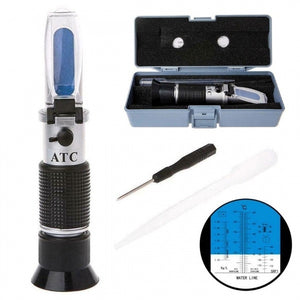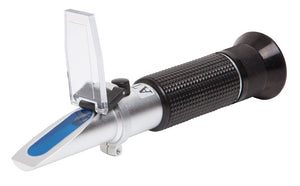Refractometer
R 999.00
Maintain proper salinity level with greater precision and convenience. Refractometer is designed specifically to measure the absolute salinity of seawater, not brine (NaCl) for true readings essential for reef aquariums housing sensitive corals. High-resolution dual scale display (salinity in ppt and specific gravity) focuses on the range relevant for reef aquariums, eliminating confusing extraneous graduations. Dual scale range of 20-40 PPT/77°F and 1.010-1.030 S.G.
Refractometer has been calibrated for the specific ionic content of seawater according to the most advanced international laboratory standards for practical salinity measurements. High accuracy seawater refractometer features Automatic Temperature Compensation for exceptional accuracy measuring the absolute salinity of seawater at a temperature of 25°C/77°F.
Main Features
- Directly reads the absolute salinity of seawater at 25°C/77°F (no need for seawater or temperature compensation factors).
- Specifically designed for the ionic content of seawater (NSW) for more accurate salinity measurement (industry standard refractometers are calibrated for salt brine).
- Calibrated for seawater (NSW) at 25°C/77°F, the normal temperature range for reef aquariums (most standard refractometers are calibrated at 15°C/59°F).
- Easier to read, higher resolution display, focused to the relevant range for reef aquariums of up to 40ppt.
- Includes Integrated Automatic Temperature Compensation (ATC) for accurate measurement at standard ambient temperature.
Did You Know?
Measuring the salinity of seawater with a refractometer calibrated for brine (NaCl) solution will result in a deviation of up to 1.5 ppt!
- Clean the glass prism and translucent flap of the refractometer with deionized (DI) water at 22-25°C and dry thoroughly with a soft cloth.
- Hold the refractometer horizontally and open the flap.
- Using the pipette provided, place a small sample of the seawater to be tested on the glass prism. Do not immerse the refractometer into the seawater.
- Close the flap on the sample and wait for 15 seconds to allow for the temperature of the sample and the refractometer to equalize.
- Point the prism end of the refractometer to a light source and look through the eyepiece. (Note: The refractive index is also dependent on the wavelength of the light source and therefore a light source close to daylight should be used.)
- The top of the screen will be blue and the bottom will be clear/white. The dividing line between the blue and white sections is where the reading should be taken.
- Adjust the focus for your individual eyesight by rotating the eyepiece until a sharp picture is achieved.
- Read the seawater salinity in ppt and/or the equivalent specific gravity (S.G.) at 25°C.
- Clean the glass prism and translucent flap of the refractometer with DI water and dry thoroughly with a soft cloth.
Calibration
Alignment should always be carried out with the instrument at 22-25°C. Allow the refractometer to stand at this temperature for 30 minutes before alignment.
- Remove the cover from the alignment screw.
- Place a sample of DI water on the glass prism and check the salinity reading as directed above.
- If the reading is not exactly on the zero ppt mark on the scale, adjust the position of the reading by rotating the alignment screw with the screwdriver provided until the reading is zero ppt.
- Replace the cover from the alignment screw.
Storage
To prevent the formation of condensation inside the refractometer, store in a dry environment.
General Information
Refractometers are optical instruments that measure the refractive index of a solution, which will vary according to its ionic composition, concentration and temperature. For accurate results, refractometers must be calibrated for the specific solution to be tested and in the correct temperature range.
Refractometer has been calibrated for the specific ionic content of seawater according to the most advanced international laboratory standards for practical salinity measurements. Measuring the salinity of seawater with a refractometer calibrated for brine (NaCl) solution will result in a deviation of up to 1.5 ppt.
Refractometer includes automatic temperature compensation. However, to avoid compensation errors, it has been calibrated at 25°C, the normal temperature range for reef aquariums. Both the ambient temperature and the water sample temperature will influence the refractive index and therefore it is recommended to use the refractometer in environments where the ambient temperature and the water to be tested are between 15-35°C.
Over time, the optical elements inside refractometers can become misaligned. Therefore, before first use and thereafter on a regular basis, the alignment of a refractometer should be checked and adjusted as necessary.
About Salinity
Salinity is a general term describing the concentration of salt in water. However, solutions of different type of salts have different refractive indexes. Brine is a solution of Sodium Chloride (table salt) that contains 2 chemical elements. Seawater contains approximately 70 chemical elements that include Calcium, Magnesium, Potassium etc. in addition to the Sodium Chloride. Seawater and Brine of the same salinity (i.e. the same weight of salt/liter) have different refractive indexes and will give different salinity readings if measured on the same refractometer.
Refraction & Refractive Index
All transparent materials such as liquids refract (distort) light. All transparent materials refract light differently and have what is called a "refractive index" which means how much a particular material distorts light. Different concentrations of the same liquid have different refractive indexes. The scale of a refractometer is calculated by using a mathematical algorithm that relates the measured refraction to its concentration for a specific liquid.
Refractive Index and Temperature
The refractive index of liquids change with temperature and therefore has a major effect on measuring salinity with a refractometer. The algorithm for defining the PPT (and S.G.) scale for a refractometer is calculated for a specific temperature.
PPT readings from refractometers that are not calibrated for reef aquariums (i.e. 25°C) need to be adjusted according to a conversion table to give the actual PPT at the aquarium temperature. This is often a cause for misinterpretation of refractometer readings.
For example, using a seawater refractometer calibrated at 20°C will give a PPT reading that is approximately 1-1.5ppt lower than the absolute salinity of the same water sample at the normal aquarium temperature of 25°C.
Therefore, Refractometer calibrated at 25°C/77°F directly reads the absolute salinity of seawater with no need for temperature compensation factor)
ATC - Automatic Temperature Compensation
Temperature is probably the biggest cause of wrong readings with a refractometer. Calibration and testing of water samples should be done after the refractometer and water sample have equalized at the correct temperature.
Automatic Temperature Compensation (ATC) compensates for a few degrees of difference between the ambient temperature and the calibrated temperature of the refractometer. Larger temperature variations will give an error of approximately 1.0ppt in the salinity reading.
You may also like
Follow
OPENING TIMES
Monday to Thursday : 09h00 - 17h30
Friday : 09h00 - 16h00
Saturday : 09h00 - 13h30
Sunday : 10h00 - 13h00
Public Holidays : 09h00 - 13h00





